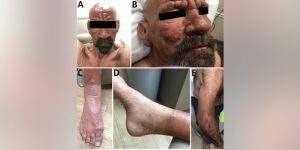Cases of leprosy are surging in central Florida, according to a recent research letter shared by the Centers for Disease Control and Prevention.
The authors said that the Sunshine State has “witnessed an increased incidence of leprosy cases lacking traditional risk factors,” with trends contributing to “rising evidence that leprosy has become endemic in the southeastern United States.”
“Travel to Florida should be considered when conducting leprosy contact tracing in any state,” they wrote.
The letter said that the number of reported leprosy cases in southeastern states has more than doubled in the last decade.
GEORGIA RESIDENT DIES FROM RARE BRAIN-EATING AMOEBA FOUND IN FRESHWATER LAKES

Lepromatous leprosy in a 54-year-old man in central Florida in 2022. (Centers for Disease Control and Prevention)
Citing the National Hansen’s Disease Program, it said 159 new cases were reported in the U.S. in 2020, with Florida among the top reporting states.
Central Florida accounted for 81% of cases reported in the state and nearly a fifth of nationally reported cases.
“Whereas leprosy in the United States previously affected persons who had immigrated from leprosy-endemic areas, ≈34% of new case-patients during 2015-2020 appeared to have locally acquired the disease. Several cases in central Florida demonstrate no clear evidence of zoonotic exposure or traditionally known risk factors,” the letter noted. Zoonotic diseases are caused by germs that spread between animals and people.
In one central Florida man, a 54-year-old without risk factors for known transmission routes, the authors reported lepromatous leprosy. Lepromatous leprosy is one of three main types of leprosy, and people who are infected with it have widespread sores and lesions. The disease is more contagious, according to the Cleveland Clinic.
The man, who has lived in the area his whole life and is a landscaper, had sought treatment at a dermatology clinic for a painful and progressive erythematous rash. He denied recent foreign or domestic travel, exposure to armadillos, prolonged contact with immigrants from leprosy-endemic countries or connections with someone known to have leprosy.
COVID HOSPITALIZATIONS ARE ON THE RISE, COULD SIGNAL ‘LATE SUMMER WAVE,’ SAYS CDC

Feet of a leprosy patient in the Curupaiti Hospital in Rio de Janeiro Sept. 13, 2018. (Fabio Teixeira/picture alliance via Getty Images)
Whereas, a high percentage of unrelated case in the South were found to carry the same unique strain of M. leprae as nine-banded armadillos in the region, suggesting a strong likelihood of zoonotic transmission.
Many cases reported in eastern United States, including Georgia and central Florida, lacked zoonotic exposure or recent residence outside the U.S., and the letter said that there is some support for the theory that international migration of persons with leprosy is a potential source of autochthonous, or native, transmission.
The authors said a link to migration may account for the increase in incidence of leprosy in historically nonendemic areas and that further reports show that rates of new diagnoses in people born outside the U.S. has been declining since 2002.
“This information suggests that leprosy has become an endemic disease process in Florida, warranting further research into other methods of autochthonous transmission,” they said.

A leprosy patient holds out his hand at the leprosy hospital in downtown Srinagar on Jan. 30, 2017. (TAUSEEF MUSTAFA/AFP via Getty Images)
“Travel to this area, even in the absence of other risk factors, should prompt consideration of leprosy in the appropriate clinical context,” the letter added.
CLICK HERE TO GET THE FOX NEWS APP
The absence of traditional risk factors in many Florida cases and the high proportion of residents who spend a great deal of time outdoors supports the investigation into environmental reservoirs as a potential source of transmission, they posit.
READ THE CDC LEPROSY LETTER – APP USERS, CLICK HERE:
Prolonged per person-to-person contact through respiratory droplets is the most widely recognized route of transmission. Leprosy, that is also known as Hansen disease, is a chronic infectious disease that primarily affects the skin and peripheral nervous system. It has been “historically uncommon” in the U.S., according to the CDC.
The World Health Organization says leprosy occurs in more than 120 countries and that more than 200,000 new cases are reported every year. As of 2019, Brazil, India and Indonesia all reported more than 10,000 new cases, while 13 other countries each reported 1,000-10,000 new cases.





